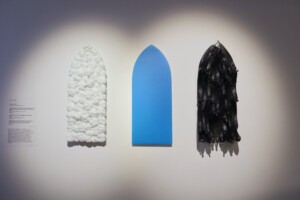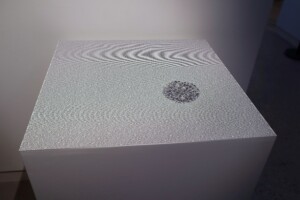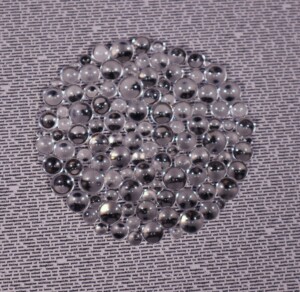New Acquisition: Steven Yazzie’s Erupter Now on View at the CAT
December 1, 2025
Jill Ahlberg Yohe, Curator of Modern and Contemporary Art
One of the best parts about being a curator is to follow an artist’s journey over the course of their career. I love seeing when artists challenge themselves to move outside their comfort zones, especially when they’ve achieved success with a particular style. I’ve been following Steven Yazzie’s work for many years, and I happen to think he’s one of the most exciting painters working today, in part because he’s constantly evolving and fearlessly embracing the new.
Yazzie recently moved from a successful painting career of figurative painting—including trickster coyote figures in art museums or in living rooms—to abstracting landscapes in the American Southwest. This shift in Yazzie’s painting style began after spending months on long bicycle rides and hiking, where he would chronicle his journeys in sketches and film. (Yazzie is also a successful filmmaker). In the mountains and along the old two-lane highways of Colorado, New Mexico, and Arizona, Yazzie understood a landscape brimming with activity, holding the same energy it has contained for hundreds of thousands of years. Landscapes—depicted in late 19th and early 20th century American paintings as barren, desolate, and dead—are places filled with life, activity and motion.
He shared with us that:
When people stand before these paintings, I hope they sense that presence, the vibration, the physical and the spiritual, the seen and unseen, because for me, that’s where the landscape truly lives…When I think about landscape, I’m not just thinking about what I see. I’m thinking about what I feel the land holds, memory, story, and transformation. It holds beauty, but also complexity. My landscape series began as a way to understand that relationship, how we experience place, not as something fixed, but as something constantly shifting alive and responsive….Mountains, canyons and flora emerge as indiscernible, yet resonant shapes creating landscapes that blur the boundary between the tangible and the imagined. Abstraction for me is not about obscuring the land, it’s about listening to it in another way. It’s a space where emotion, rhythm, and presence take form.
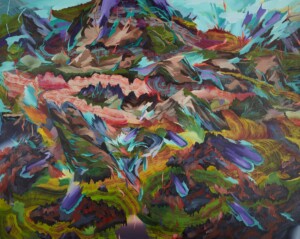
Steven J. Yazzie (Navajo Nation, born 1970). Erupter, 2024. Oil on canvas. Cafesjian Art Trust Museum, 2025.429
Come see Erupter, now on view at the CAT in our lobby, and discover your own personal responses to Yazzie’s work and what abstract landscapes may mean (and feel) for you.
3 Must-See Works in Collidoscope
November 1, 2025
The Cafesjian Art Trust Museum is thrilled to be hosting Collidoscope: De la Torre Brothers Retro-Perspective. This colorful, dazzling, maximalist tour de force will only be on view at the CAT for a limited time. Although the CAT has purchased three of the artworks to add to our permanent collection, everything else you see in the exhibition will only be here temporarily.
Below, Assistant Curator of Glass Linnea Seidling highlights three artworks from Collidoscope you should be sure not to miss:
Feminencia
My absolute favorite lenticular print in the exhibition is Feminencia. This monumental work features two digital collages that flip back and forth using lenticular printing technology. These digital collages are made up of photographs from the brothers’ travels, as well as from images of women copied and pasted from Old Master European paintings. The title of this work is a combination of the Spanish words for feminine (femenina) and eminence (eminencia). The brothers illustrate two different types of feminine power: in one image, the wisdom and compassion of White Tara, a goddess in the Buddhist pantheon; and in the other, the sexual power of women, overwhelming the central male figure, King Leopold I of Belgium.
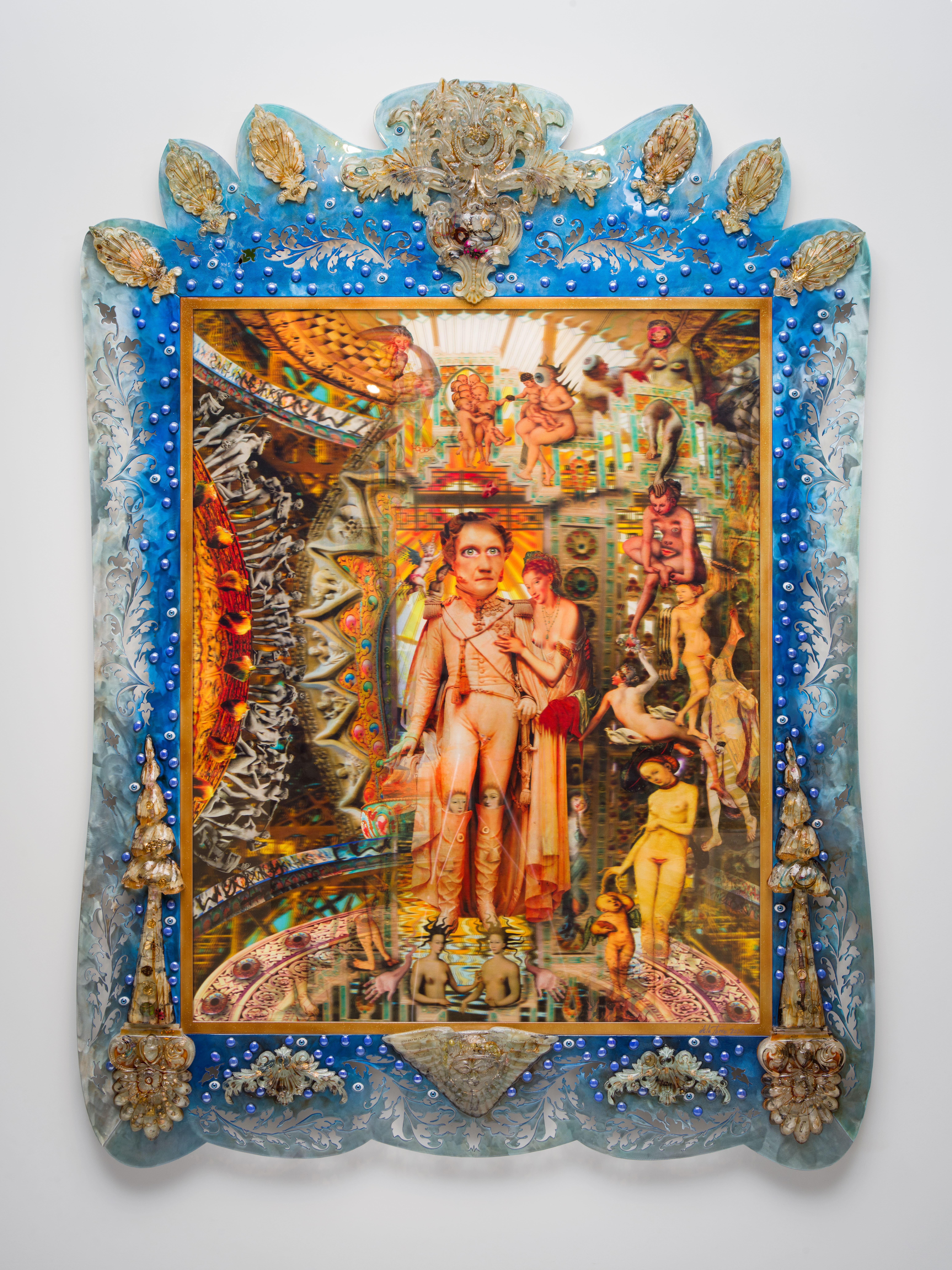

October is American Archives Month!
October 1, 2025
Archives are places where materials of significant historical and/or future value are stored. At an art museum, the types of materials kept can include artist papers, photographs, information about art objects and exhibitions, correspondence, and schematics, among many other things. Most materials in an art museum archive can be used as primary sources for research, offering firsthand information that can help scholars, curators, and the public gain understanding into artistic processes, the histories of works of art, or even practical things like the instructions on how a work of art is supposed to be assembled.
The Cafesjian Art Trust Museum (the CAT), though still new, has a range of materials related to its collections in its archives. Celebrate American Archives Month with us as we feature some of the highlights from the CAT’s archives!
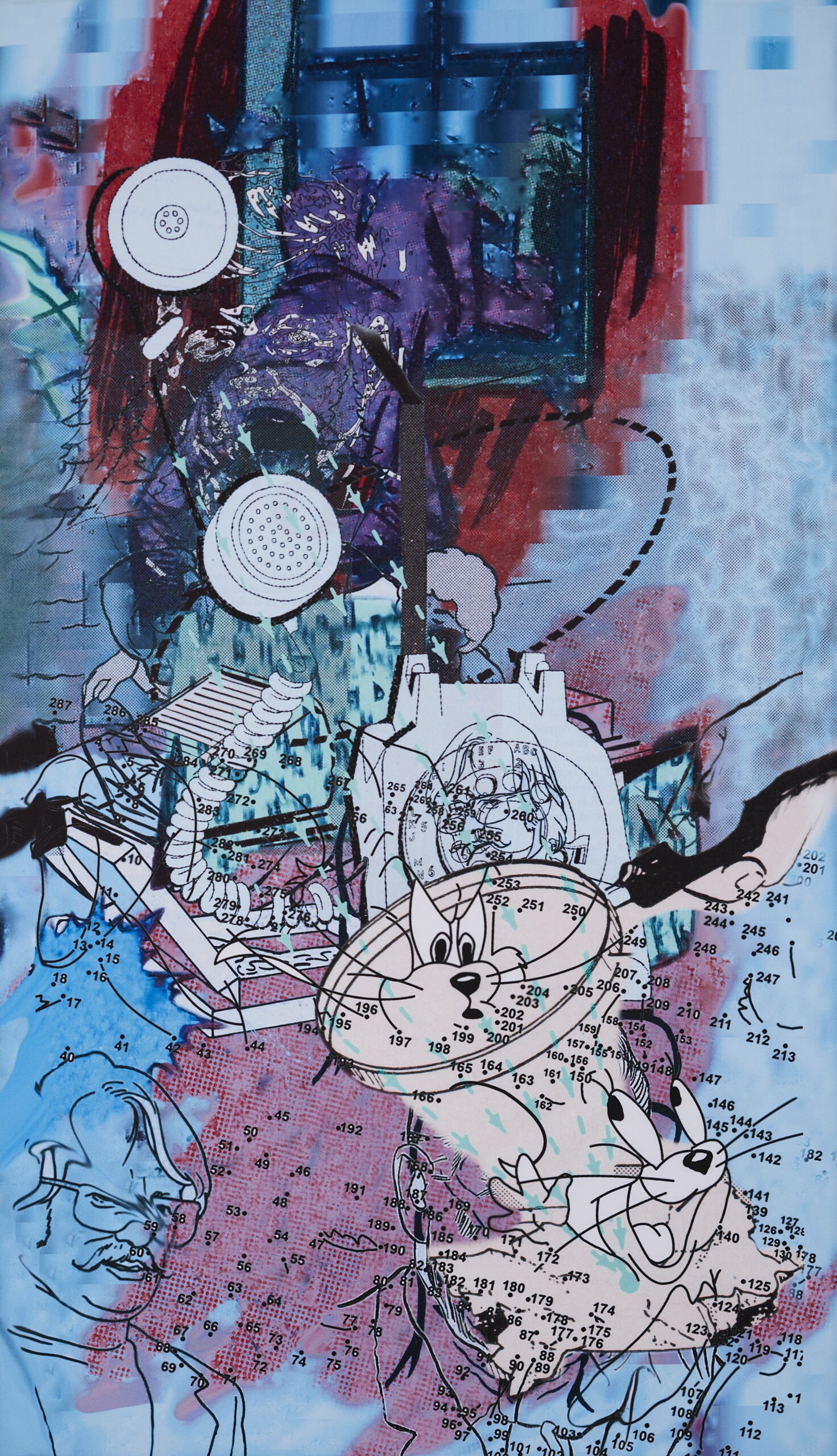
In 2023, the CAT acquired a multimedia work by artist Jibade-Khalil Huffman. Since then, it has been featured in both the CAT’s inaugural Recent Acquisitions exhibition and the Los Angeles County Museum of Art’s exhibition Digital Witness: Revolutions in Design, Photography, and Film.
Part of this work’s archival records include the transcript from an interview the CAT conducted with Huffman in 2023 to learn more about his philosophies and methodologies.
The CAT Awards Its First Prize at the State Fair
September 1, 2025
Linnea Seidling, Assistant Curator of Glass
The State Fair holds a special place in the hearts of all Minnesotans, and for the CAT, it is no different. In a blog post last year, we shared about the connection that Gerard Cafesjian, whose collection forms the core of the CAT’s holdings, had with the Fine Arts Center. The museum’s collection includes many of the artworks he purchased there over the years. In honor of his love of the State Fair, the CAT is sponsoring an annual award at the Fine Arts Center. The Cafesjian Art Trust Museum Prize will be awarded to one outstanding artwork each year.

A quiet Fine Arts Center on judging day.
Art and Inventory: My Summer at the CAT
August 1, 2025
Laniah Mars, The CAT Summer Intern
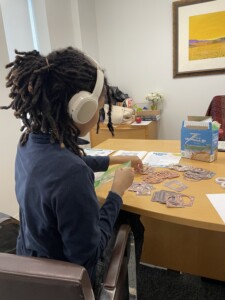
If anyone ever tells you that working at a museum is always quiet and calm, they’ve clearly never spent a summer at the CAT.
Let me start by saying this: preparing a museum tour is not for the weak. Yes, you can know an exhibition like the back of your hand—but the mental and emotional prep behind turning that knowledge into a tour that can inspire third graders, elders, and social media followers alike? It’s not running a marathon; it just requires the same stamina. You rehearse facts you already know, and yet you still sweat the timing, the phrasing—the moment a child asks a question before you get to finish. Or, worse, when no one asks anything at all. You’re not just walking people through a space. You’re walking them through time and culture; through someone’s life. That’s pressure.
My coworkers, who were really my mentors, were nothing short of incredible. I could start a morning helping kids explore antique art pieces older than their grandparents, then spend the afternoon filming TikToks with the marketing team. The contrast was as entertaining as it sounds. The CAT Museum has a pulse, a rhythm that swings between two worlds.
Family Fun: Tips for Bringing Kids to the Museum
July 1, 2025
Laura Steefel-Moore, Director of Education and Community Engagement
The CAT welcomes visitors of all ages, including very young children! Want to engage your little ones at the museum, but not sure where to start? Here are some suggestions to help make the most of your visit:
Know before you go
- Food and drink are not allowed in the museum, so please leave all snacks and water bottles in the car. The museum has a water cooler in the lobby for visitor use.
- Breast and bottle feeding are allowed throughout the museum. If you prefer a private area, our staff will show you where to go.
- We have changing tables and stepstools in the men’s and women’s bathrooms. If you need a single-user bathroom, just ask staff.
- If helpful, review our social narrative in advance of your arrival.
- Don’t worry about short attention spans—if you are only in the gallery for 10 minutes, that’s fine! The museum is free and you can always come back.
Robert Indiana: A Love Story
June 1, 2025
Jill Ahlberg Yohe, Curator of Modern and Contemporary Art
Robert Indiana’s Love sculptures are one of the most recognizable and beloved works of contemporary art. Starting in June, one will be on permanent display in the outdoor sculpture space at the Cafesjian Art Trust Museum. The monumental sculpture and its base stands 8 feet tall and 6 feet wide, perfect for you and your and your bestie to take a selfie and share the love.
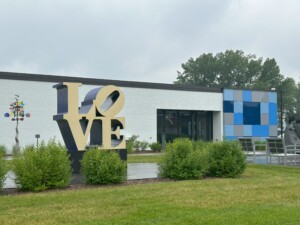
Iconic Love sculptures can be found all over the world, from Singapore to Scottsdale and now in Shoreview, Minnesota. Robert Indiana created several series of these sculptures from 1966–2002 in several sizes and colors. What is special about the CAT’s Love sculpture? It happens to be the only one in this color combination currently on view for the public; all others are in private hands. Only twelve Love sculptures in warm gold and ultramarine blue were ever produced, and now you can experience one for yourself.
Cheers to Our Inaugural CAT Teen Council!
May 1, 2025
On May 3, we celebrate the opening of a very special exhibition in our Focus Gallery. Spiral: A CAT Teen Council Exhibition was curated by the 2024-25 Teen Council and offers their unique perspectives on the museum’s collection. The teens chose an eclectic mix of ten objects, ranging from a giant glass dog to an unopened perfume bottle to a 12-hour-long video. They then wove together the objects using creative storytelling.
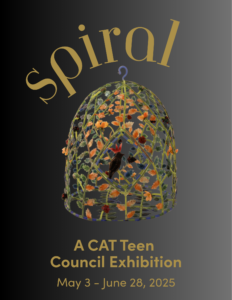
The exhibition, on view through June 28, is the culmination of this year’s inaugural Teen Council program. Beginning in October 2024, six local high schoolers met once a month throughout the school year to learn about the CAT and what it’s like to work in an art museum. They met with museum staff, got behind-the-scenes tours, produced their own public program, and had the opportunity to connect with other like-minded teenagers both near and far.
Click below to see some of the highlights from the year!
Gerard Cafesjian 100th Birthday
April 1, 2025
This April marks what would have been the 100th birthday of Gerard L. Cafesjian (1925-2013), the art lover and Twin Cities businessman whose collection forms the foundation of the CAT Museum.
Mr. Cafesjian was born on April 26, 1925 in Brooklyn, New York, to Armenian immigrant parents.
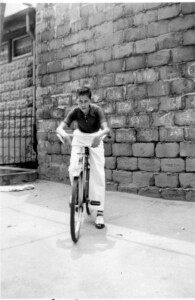
From an early age, Mr. Cafesjian loved art and sought opportunities to surround himself with it. Although his family did not have much money, Mr. Cafesjian took advantage of free museums in New York City, including the world-class Metropolitan Museum of Art. This deep appreciation for human creativity and unique art forms would stay with him throughout his life.
During World War II, Mr. Cafesjian served in the United States Navy on the USS Oceanographer and the USS AndresDuring the war, he met nurse Cleo Thomas, and after the war they married. Mr. Cafesjian went on to earn an undergraduate degree in economics at Hunter College before earning his Juris Doctorate at St. John’s School of Law. He began work as a legal editor for West Publishing while still living in New York City. The company then transferred him to Minnesota, where they had their headquarters, thus establishing Cafesjian family roots in the St. Paul area. Mr. Cafesjian eventually became West Publishing’s executive vice president in charge of sales, marketing, and public relations. He retired in 1996.
Meet the Curators
March 1, 2025
The CAT Museum is thrilled to have a dynamic new curatorial team at the helm: Dr. Jill Ahlberg Yohe, Curator of Modern and Contemporary Art, and Linnea Seidling, Assistant Curator of Glass. Ahlberg Yohe joined the staff in December 2024, and Seidling was recently promoted from her former position as the Museum’s Director of Communication and Events.
Ahlberg Yohe has more than a decade of experience producing innovative exhibitions, scholarship, and programming as an independent consultant and museum curator. She earned her PhD from the University of New Mexico and served for many years at the Minneapolis Institute of Art as the associate curator of Native American Art, during which time she organized notable exhibitions including “Hearts of our People” and “In Our Hands.” In addition to her extensive knowledge of contemporary artists, Indigenous cultures, and the Twin Cities arts scene, Ahlberg Yohe embodies a commitment to meaningful community engagement.
Ahlberg Yohe works closely with Seidling, who has an extensive background in decorative arts and glass history. Seidling holds an MA in the History of Decorative Art, Design, and Material Culture from the Bard Graduate Center in New York City and has worked in curatorial positions at the Museum of Fine Arts, Boston, the J. Paul Getty Museum, and the Corning Museum of Glass.
We sat them down for a discussion about the role of a curator in a 21st-century art museum, their vision for the future of the CAT, and their opinion about the age-old debate: cats versus dogs.
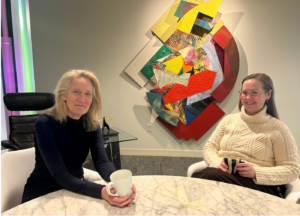
Dr. Jill Ahlberg Yohe, Curator of Modern and Contemporary Art, with Linnea Seidling, Assistant Curator of Glass.
A Love Letter to the CAT’s Collection
February 1, 2025
In celebration of Valentine’s Day, this month the staff of the Cafesjian Art Trust Museum are sharing what work in the Museum’s collection they love the most. With a collection of over 4,000 works, it was a challenge pick just one! See below what they selected.
Laura Steefel-Moore, Director of Education and Community Engagement:
I’m loving Ronald Merchant’s Red Light, Red Wing. It’s a really pleasant slice of life depicting a warm Minnesota day. The figures in it look unassuming and relatable, so I like imagining myself standing near them, soaking up the bright sunlight.
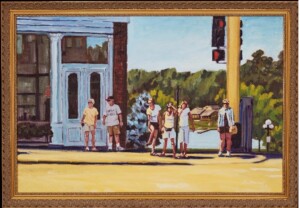
Ronald Merchant (American, born 1950). Red Light, Red Wing, 2005. Oil paint on canvas. H: 27 ½ in., W: 39 ½ in., D: 1 ½ in. Cafesjian Art Trust Museum 2024.322.1.
A 2024 To Remember!
January 1, 2025
2024 was a year of incredible growth and community-building for the CAT Museum. Our team expanded to include a Director of Education and Community Engagement, and we created a brand-new curatorial department, consisting of a Head Curator and an Assistant Curator of Glass. We continued to rely on our volunteers to lead tours and facilitate meaningful experiences for our guests. More than 20 wonderful volunteers gave over 700 hours to the museum last year, bringing the collection to life in a multitude of ways. Click below to access the 2024 Annual Report!
Drop-In Events, Winter Coat Drive, and More at the CAT
December 1, 2024
The holiday season is a time for gathering with those you love and sharing with those in need. This December, the CAT Museum is doing just that! In addition to our regular guided tours by reservation only, guests will have two opportunities this month to visit the museum reservation-free. We are also hosting a winter coat drive all month long, and we’ll need your help to make sure kids in our community can stay safe and warm.
Drop-In Events in December
On Friday, December 6th from 5:30 pm–7:30 pm, the CAT will be open for the perfect cozy night out. See our current exhibition, From Origins to Horizons: The American Studio Glass Movement, and head next door to Churchill Street to purchase a Glass Menagerie, a specialty cocktail inspired by the CAT Museum. This gin martini is flavored with house-made clarified tomato and features a cherry tomato and olive oil garnish. It is a perfect farewell to the warmer weather as we move into winter.
The CAT Museum will also be open to drop-in guests all day on Saturday, December 21st from 10:00 am–4:30 pm. Bring your guests in town for the holidays to see From Origins to Horizons on the last day before it closes.
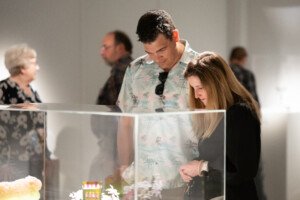
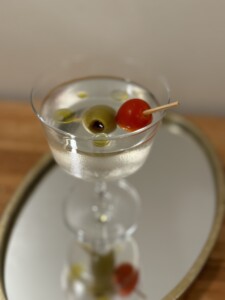
Winter Coat Drive
The CAT Museum will be collecting youth winter gear all December long on behalf of Project for Pride in Living, a local non-profit that provides affordable housing and career readiness services. When you make your visit to the CAT, bring along coats, snowpants, winter boots, or mittens for children of all ages. New or in-great-condition (no pet hair, stains, or damage) donations only, please.
The CAT Museum is a proud partner of Project for Pride in Living’s LEAP program serving young adults.

Preview of Changes to Come
The drop-in days in December are just a preview of exciting things to come to the CAT in January. Our exhibitions will soon be easier for families, students, and those who work during the week to visit. When our next exhibition Echoes of Life: Paintings from the Collection opens January 24, visitors will be able to drop in every Saturday without making a reservation! Thursdays and Fridays will be business as usual for the CAT, with tours by reservation only at 10 am, 1 pm, and 3 pm. But on Saturdays, you can drop by any time between 10:00 am–4:30 pm. Come when you like, stay as long as you like, and return as often as you like!
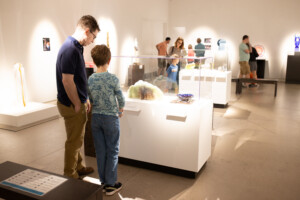
The team at the CAT wishes everyone a happy holiday season, and we hope that you include us in your plans this month!
Painting with Gratitude: Joshua Cunningham Revisits a Painting at the CAT Museum
It is a special moment when an artist can see their work on display at a museum. Painter Joshua Cunningham (American, born 1974) recently visited the Cafesjian Art Trust Museum to see his painting, Along the Line, on display in the new Focus Gallery exhibition, Vantage Points: Landscape Paintings from the Collection, open through December 21, 2024. The CAT Museum’s Director of Collections, Ashley Walker, interviewed Cunningham during his visit to learn more about his artistic process, and the painting in the Museum’s collection. Below are excerpts from this conversation that discusses Cunningham’s influences, process, and when he sold this painting to Gerard Cafesjian.
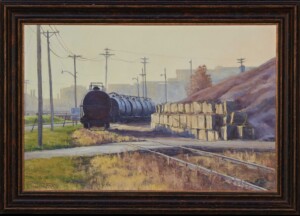
Joshua Cunningham (American, born 1974). Along the Line, 2010. Oil paint on linen. Cafesjian Art Trust 2024.272.1.
On how he began painting trains:
But [this painting] stood out because…it was a high watermark for me at that time in my life as a painter. To take an idea through several iterations and really continue to flush it out. It’s also a place where my mentor painted…Joe Paquette also painted down and around [Child’s Road in Saint Paul]. He had a real heart for industrial stuff…His dad was a foreman in industrial New Jersey…He taught a workshop in New York….And we’re in this apartment in Soho—someone is hosting us for dinner—and he’s looking out across the Hudson, and he’s like, “That’s where my dad [used to work.} I used to go on Saturdays with my dad to the job sites,” and he starts telling the stories, and this big light goes on in my head: Oh my goodness, he’s not painting industrial stuff to be edgy and cool, that’s actually a part of his childhood. So for me, that opened up parts of my painting life. It opened up a door.
I was such an impressionable student that whatever my mentors were doing, [I was doing]. This is over the top expression—but in the Jewish tradition, when you have a rabbi, you’re doing everything the rabbi does. It’s not just learning what he’s reading. It’s, how is he talking to other people? And so, when I went into my art trainings…I’m trying to learn everything they’re doing because you don’t know which part of it is painting. And then in time…they’re a part of your story. And so then his love of industrial stuff, like for me, the trains….it’s a way of thinking about him, and how grateful I am for what he brought me into. But also, as a kid, my grandpa had a model railroad in his basement that me and my twenty-five other first cousins would get to play with.
Spooky Selections from the CAT Collection
Digging through the CAT Museum’s collection of over 4,000 artworks can sometimes get a little spooky. Our Director of Collections, Ashley Walker, put together a list of the scariest objects she has come across so far. They are listed below from least to most frightening. Only the bravest readers will make it to the end!
1 out of 10 Scaries:
This person In Disguise is both endearing and a little creepy.
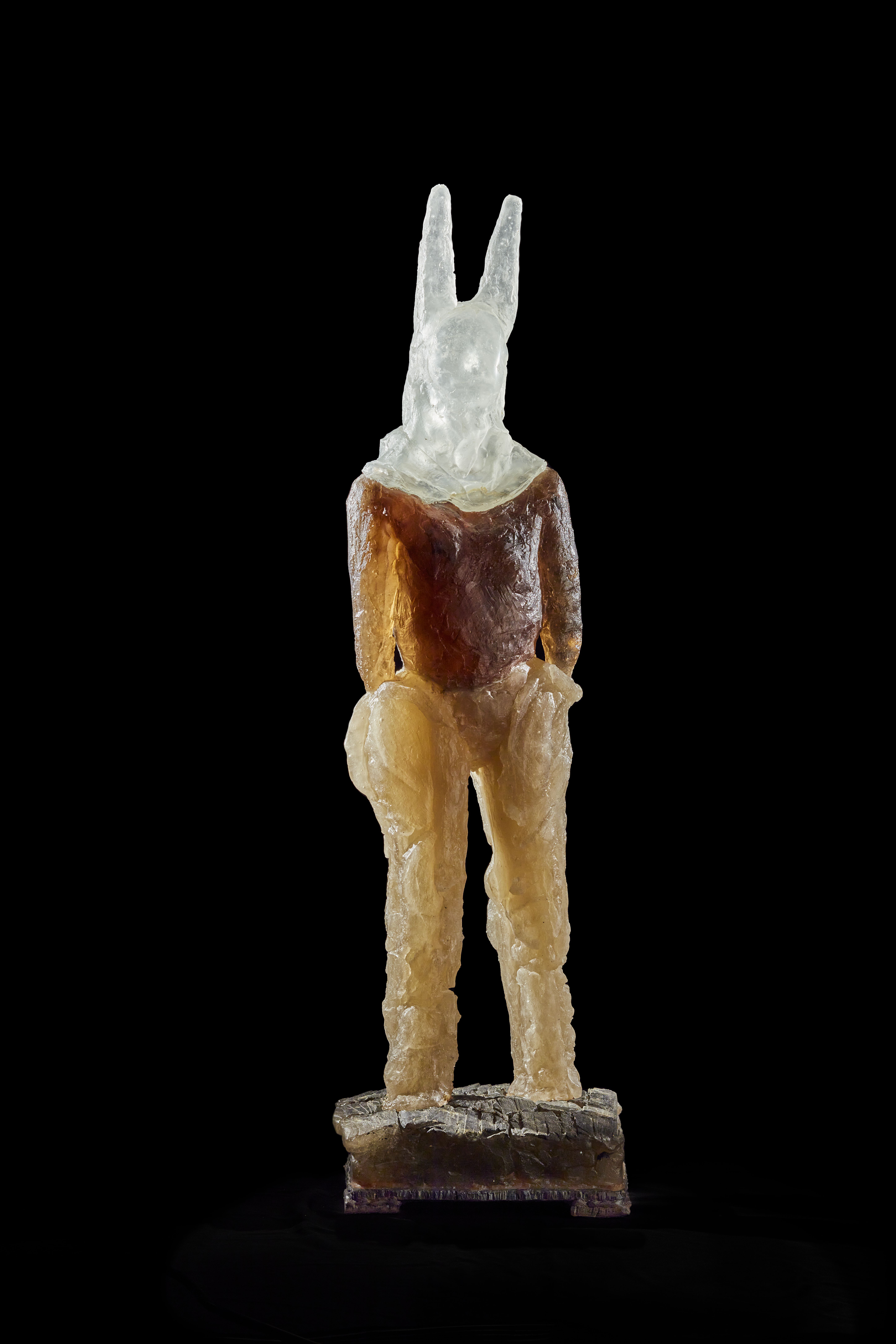
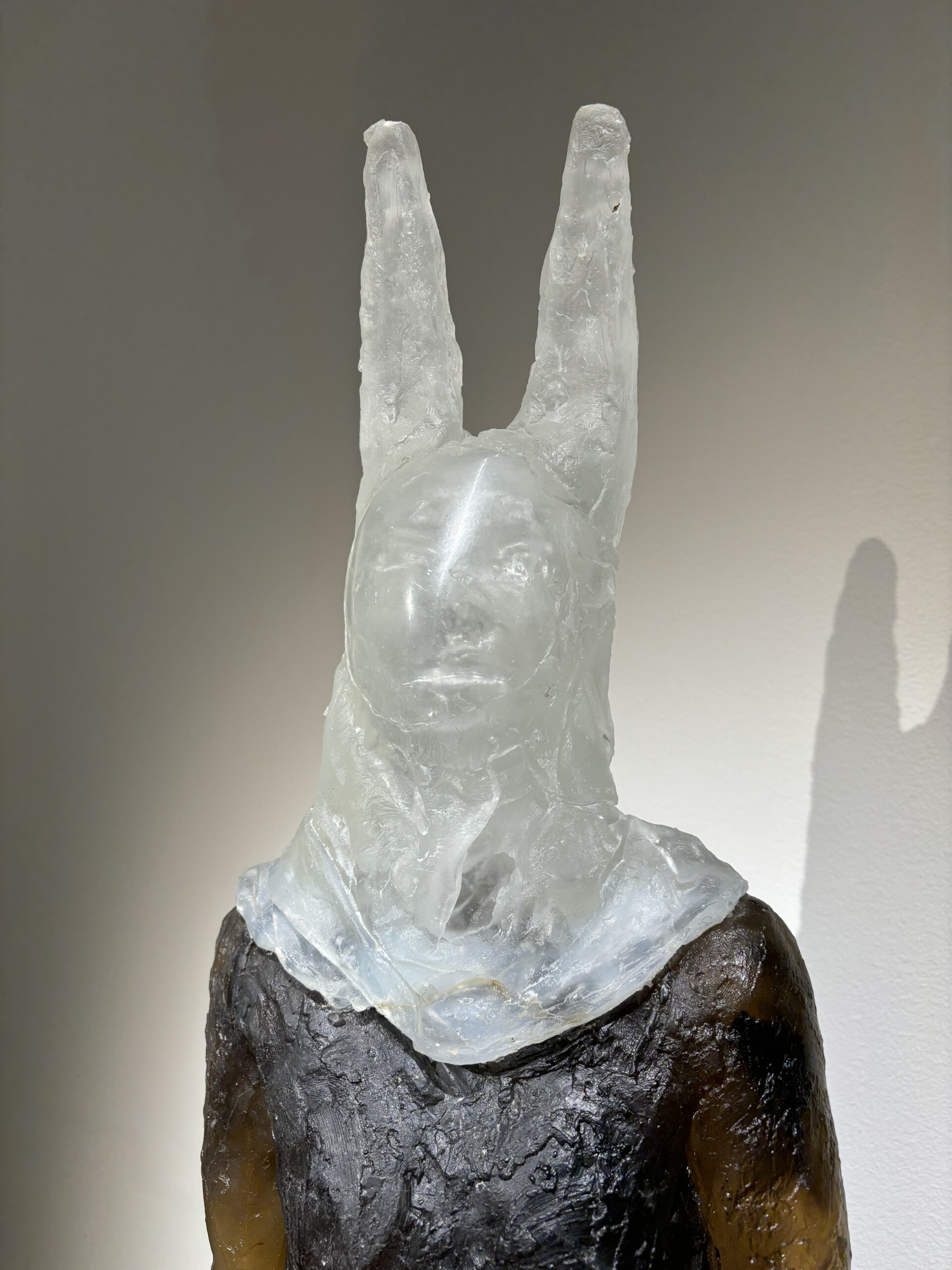
Janusz Walentynowicz (American, born Poland, 1956). In Disguise, 1993. Cast glass and steel. 37 3/8 × 10 1/2 × 8 1/2 in. Cafesjian Art Trust 2023.187.1.
2 out of 10 Scaries:
A night spent in this Spirit House would result in a few ghost encounters.
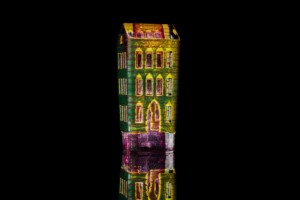
José Chardiet (American, born Cuba, 1956). Spirit House, 1987. Cased, hot-worked, and sandblasted glass. 7 1/4 × 3 1/8 × 3 1/8 in. Cafesjian Art Trust 2023.177.2.
From Origins to Horizons Extended!
The CAT Museum is delighted to announce that our current exhibition, From Origins to Horizons: The American Studio Glass Movement, originally set to close in October, will now be open through December 2024. “The exhibition has been so popular with visitors that we want to give more people the opportunity to enjoy it, as well as welcome back some of our biggest fans,” explains President and CEO Kathie Baradaran. So far, the CAT has provided public tours of this exhibition to 2,100 guests and counting.
Crowd Favorites
Although each work in the exhibition is outstanding in its own way, there are a handful of works that have become visitor favorites. Mark Peiser’s Moon and Landscape and Amber Cowan’s Willie the Mouse with Tractor and Train have without a doubt risen to the top with the CAT’s guests.

Mark Peiser (American, born 1938). Moon and Landscape, Innerspace series, 1991. Cast, cut, laminated, and polished glass. Cafesjian Art Trust 2023.146.3.
Check out a YouTube video highlighting Moon and Landscape.
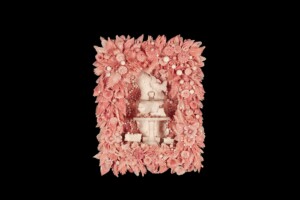
Amber Cowan (American, born 1981). Willie the Mouse with Tractor and Train, 2023. Flameworked glass, found glass, painted aluminum, wire, silicone. Cafesjian Art Trust 2023.180.5, partial gift of Heller Gallery.
Check out a YouTube video highlighting Willie the Mouse with Tractor and Train.
Art from the Great Minnesota Get-Together
For most Minnesotans, the State Fair brings to mind fried food on a stick, baby farm animals, carnival games, and live performances. For Gerard Cafesjian, however, the State Fair was a chance to buy artwork from Minnesota artists. As we gear up for the “Great Minnesota Get-Together” at the end of the month, we wanted to shine a light on Gerard’s love of collecting art at the State Fair.
Gerard’s daughter Kathie, the museum’s CEO and founder, remembers that her father got to know many of the artists who exhibited at the State Fair. It was always important to him to encourage and support local artists, and he did so with gusto! He became such a prolific buyer that he was invited to visit the Fine Arts Exhibition a day early, before it opened to the public. This became an important annual day on his calendar, one he would rearrange his schedule to accommodate. He continued collecting art at the Fair up until 2013, the year he died.
After Gerard’s death, his art collection became a part of the Cafesjian Art Trust. Kathie opened the Museum in 2022 to share the vast and eclectic collection with the public. Although perhaps best known for its holdings in glass art, the Museum’s collection today includes fifty artworks purchased at the State Fair.
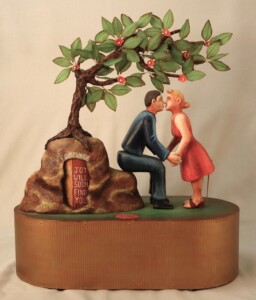
Dean Lucker (American, active since 1987). Kissing Couple Fortune Telling Machine, 1997. Wood, metal, plastic. Cafesjian Art Trust, 2024.319.1.
Q&A with the Curator: American Studio Glass at the CAT Museum
Two new exhibitions now open at the Cafesjian Art Trust Museum tell the story of American studio glass from its beginnings through today. From Origins to Horizons: The American Studio Glass Movement begins in the mid-1960s when ceramics professor Harvey Littleton hosted a series of workshops to experiment with blowing glass in a small, artist studio setting. The exhibition concludes with work created in the past five years from internationally known glass artists. Midwest Voices in Contemporary Glass, on display in the adjacent Focus Gallery, shows museum guests what artists in our very own region are creating today. In the interview below, Andy Schlauch, the CAT’s executive director and curator of the exhibitions, gives further insight into these exciting projects. From Origins to Horizons: The American Studio Glass Movement, and Midwest Voices in Contemporary Glass are on display at the CAT Museum through October 5th, 2024.
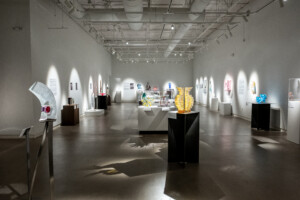
From Origins to Horizons: The American Studio Glass Movement
Q: Why did you want to organize an exhibition about the American Studio Glass Movement?
Andy Schlauch (AS): Since we have such a remarkable and deep collection of glass art, I wanted to develop an exhibition that provides a context for this uniquely American movement. There are so many great artists working in glass, and I hope our guests are intrigued to learn about it.
To learn more and book your visit to the exhibitions, visit us online HERE.
Students and Science and Zebras…
Oh My!
If you’ve visited the CAT Museum before, you might know that we have a 25-person maximum for gallery tours. So how did we manage to engage the entire third grade at Island Lake Elementary with our last exhibition, Fooling the Eye? Simple: we brought the museum to them! Our Director of Education and Community Engagement, Laura Steefel-Moore, made seven visits to the school, creating an “in-house field trip” experience for each of Mrs. Gentry’s STEAM classes, ultimately serving all of the school’s 180 third-graders. STEAM—an acronym for science, technology, engineering, arts, and math—was the perfect framework with which to study Fooling the Eye.
The 55-minute classroom lesson began with a map showing the CAT Museum in relation to Island Lake Elementary. Many students were surprised to discover they have a world-class art museum only eight minutes away from their school. They were especially delighted to learn that they could visit the museum for free with their families.
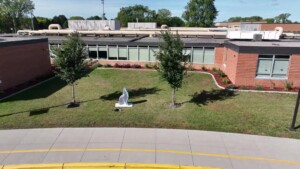
Island Lake Elementary School. Photo courtesy of Mounds View Public Schools.
For more on School Programs at the CAT Museum, visit us online HERE.
VISIT
The Cafesjian Art Trust Museum is free and open to the public. Both individuals and groups are encouraged to visit.
Thursdays and Fridays, 10:00am, 1:00pm, and 3:00pm: Tours by Reservation Only.
Fridays drop-in 5:00pm-8:00pm
Click “Book Tickets” to make your tour reservation.
Saturdays, 10:00am–4:30pm: Drop-in any time
Cafesjian Art Trust Museum
4600 Churchill Street
Shoreview, MN, 55126
VISIT
The Cafesjian Art Trust Museum is free and open to the public. Both individuals and groups are encouraged to visit.
Thursdays and Fridays, 10:00am, 1:00pm, and 3:00pm: Tours by Reservation Only
Fridays drop-in 5:00pm-8:00pm
Click “Book Tickets” to make your tour reservation.
Saturdays, 10:00am–4:30pm: Drop-in any time
Cafesjian Art Trust Museum
4600 Churchill Street
Shoreview, MN, 55126
VISIT
The Cafesjian Art Trust Museum is free and open to the public. Both individuals and groups are encouraged to visit.
Thursdays and Fridays, 10:00am, 1:00pm, and 3:00pm: Tours by Reservation Only
Fridays drop-in 5:00pm-8:00pm
Click “Book Tickets” to make your tour reservation.
Saturdays, 10:00am–4:30pm: Drop-in any time
Cafesjian Art Trust Museum
4600 Churchill Street
Shoreview, MN, 55126



